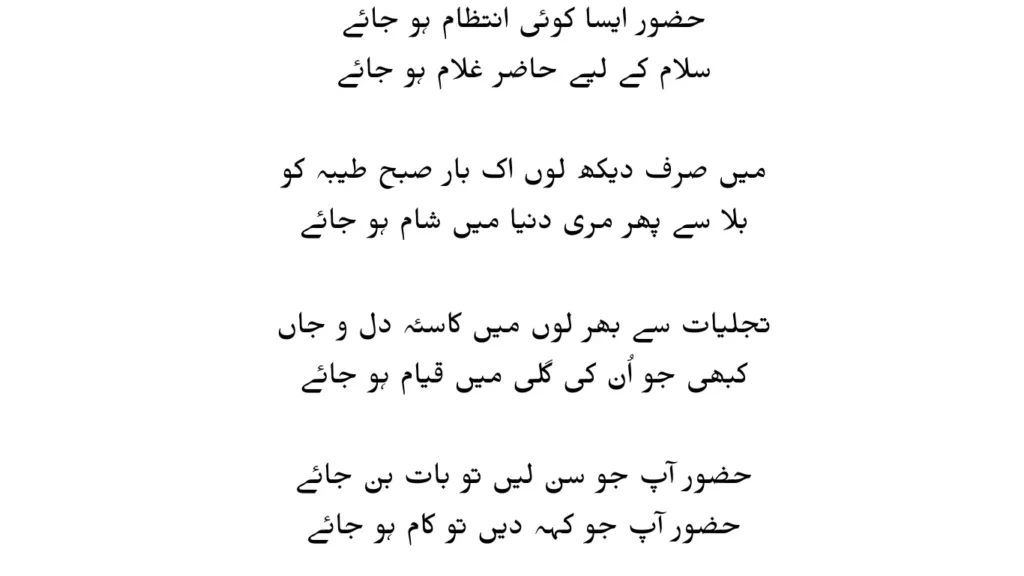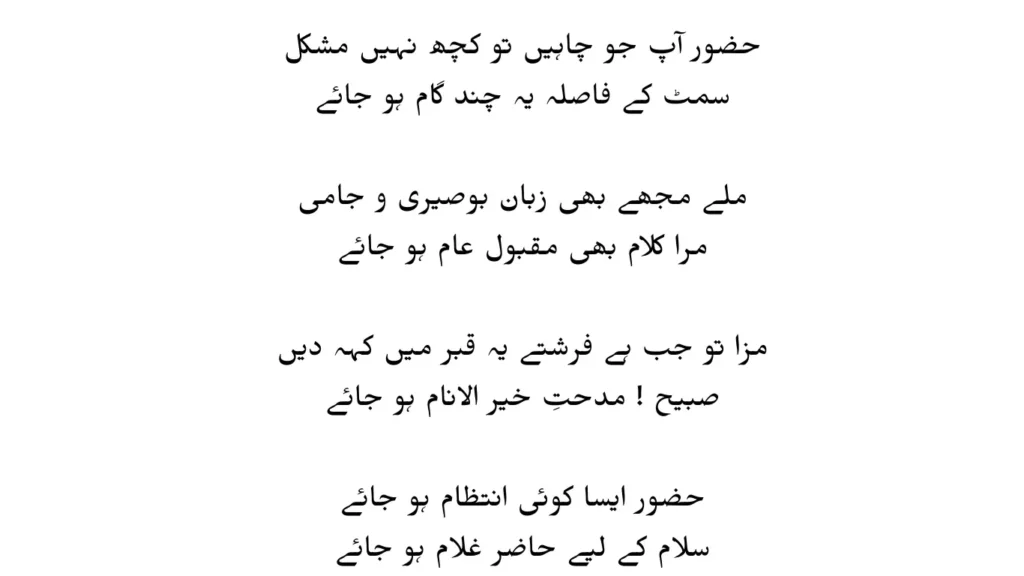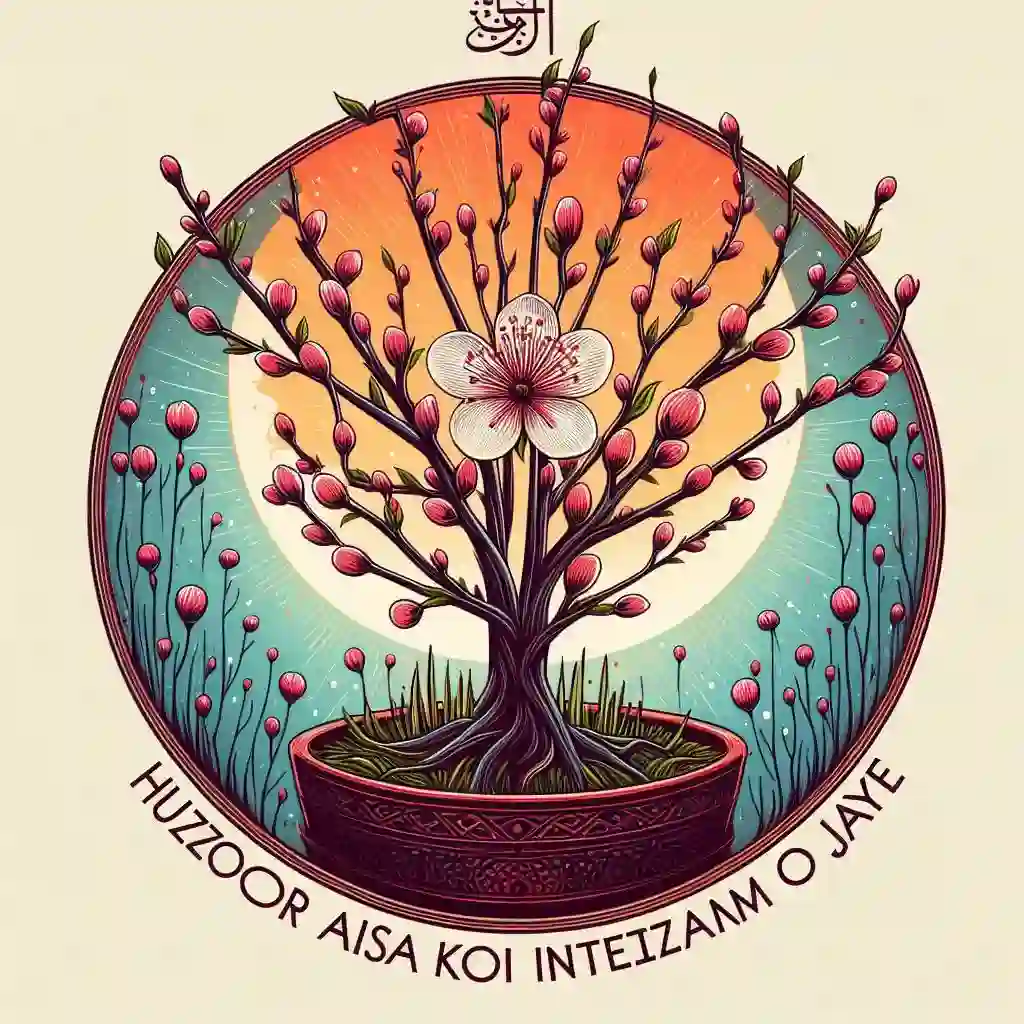The naat Huzoor Aisa Koi Intezam Ho Jaye is a masterpiece of spiritual poetry that conveys a devotee’s intense love and devotion for the Prophet Muhammad (PBUH). Its verses are filled with heartfelt prayers, longing, and a deep sense of connection to the divine. Let’s analyze each verse of this naat to uncover its profound meanings.
| Tamanna Muddaton Se Hai Naat Lyrics |
| huzoor meri to sari bahar aap se hai urdu lyrics |
| Is Karam Ka Karoon Shukar Kaise Ada Lyrics |
| Ab Mujhe Koi Sakina Nahi Kehta Baba Lyrics |
1. Huzoor Aisa Koi Intezam Ho Jaye
Salam Ke Liye Hazir Ghulam Ho Jaye
The opening lines are a plea for an arrangement where the devotee is always present to offer salutations (Salam) to the Prophet Muhammad (PBUH). These lines highlight a deep desire to be perpetually connected to the Prophet through love and devotion.
Analysis
- Salam Ke Liye Hazir Ghulam: This phrase reflects the ultimate humility of being a servant ready to honor the Prophet.
- The tone is reverent and filled with longing.
2. Mein Sirf Dekh Loon Ek Baar Husn E Taiba Ko
Bala Se Phir Meri Duniya Main Shaam Ho Jaye
This verse expresses an ardent wish to witness the beauty of Husn-e-Taiba (the beauty of Madinah). The devotee says that even if life becomes difficult afterward, seeing the beauty of the Prophet’s city just once would suffice.
Analysis
- Husn-e-Taiba: Refers to the unparalleled beauty of Madinah, a city revered by Muslims worldwide.
- Bala Se Phir: Highlights the willingness to endure hardships after experiencing this divine blessing.
- The verse conveys the intensity of the desire to connect with the Prophet’s city.
3. Tajalliyaat Se Bhar Loon Main Apna Qaasa-E-Dil O Jaan
Kabhi Jo Unki Gali Main Qayaam Ho Jaye
The poet wishes to fill his heart and soul with divine light (Tajalliyaat) by standing in the Prophet’s blessed streets. This verse reflects the yearning for a transformative spiritual experience.
Analysis
- Tajalliyaat: Refers to divine manifestations or lights that fill the soul with tranquility and faith.
- Unki Gali Main Qayaam: Symbolizes being in the holy presence of Madinah, where spiritual blessings abound.
4. Huzoor Aap Jo Sunle To Baat Ban Jaye
Huzoor Aap Jo Kehde To Kaam Ho Jaye
Here, the devotee believes that if the Prophet listens or speaks on their behalf, all matters will be resolved. This reflects the deep trust and faith Muslims place in the intercession of the Prophet Muhammad (PBUH).
Analysis
- Sunle To Baat Ban Jaye: Highlights the miraculous power of the Prophet’s acceptance.
- Kehde To Kaam Ho Jaye: Emphasizes the Prophet’s role as a source of divine mercy and support.
5. Huzoor Aap Jo Chahe To Kuch Nahi Mushkil
Simat Ke Faasla Ye Chand Gaam Ho Jaye
This verse conveys the belief that with the Prophet’s will, no challenge is insurmountable. Even the greatest distances can be shortened if the Prophet wishes so.
Analysis
- Kuch Nahi Mushkil: Reflects the omnipotence of divine assistance when sought through the Prophet.
- Simat Ke Faasla: Represents the bridging of distances, both physical and spiritual.
6. Mile Mujhe Bhi Zabaan E Busiri-O-Jaami
Mera Kalaam Bhi Maqbool E Aam Ho Jaye
The poet prays for eloquence like the legendary Islamic poets Busiri and Jami, whose works are widely admired. This reflects a desire to compose verses that inspire and touch hearts.
Analysis
- Zabaan E Busiri-O-Jaami: Alludes to poetic excellence in praising the Prophet.
- Maqbool E Aam: Reflects the wish for universal acceptance of one’s words, much like those great poets.
7. Maza To Jab Hai Farishte Yeh Qabr Main Keh Dain
Sabih Midhat-E-Khair Ul Anaam Ho Jaye
The poet envisions the ultimate joy when angels praise their devotion to the Prophet in the grave. This verse underscores the eternal significance of one’s love for the Prophet.
Analysis
- Farishte Qabr Main Keh Dain: Represents the reward of devotion in the hereafter.
- Midhat-E-Khair Ul Anaam: Refers to the praise of the Prophet, who is the best of creation.
huzoor aisa koi intezam ho jaye lyrics in urdu


Themes and Relevance of the Naat
- Devotion: The naat encapsulates the essence of a Muslim’s love for the Prophet Muhammad (PBUH).
- Spiritual Longing: Each verse conveys a yearning for nearness to the Prophet and his blessings.
- Faith and Hope: The naat reflects unwavering trust in the Prophet’s intercession.
- Poetic Beauty: The elegant use of metaphors and imagery makes it spiritually uplifting.
FAQs:
The phrase means, “O Prophet, may there be such an arrangement,” expressing a wish for divine blessings and the opportunity to honor the Prophet Muhammad (PBUH).
This naat is loved for its poetic beauty and profound emotional connection with the Prophet Muhammad (PBUH), making it a source of spiritual inspiration for many.
The main theme is a devotee’s love and longing for the Prophet Muhammad (PBUH), seeking divine blessings and nearness to his presence.





Truly no matter if someone doesn’t understand after that its up to other viewers that they will help, so here it happens.